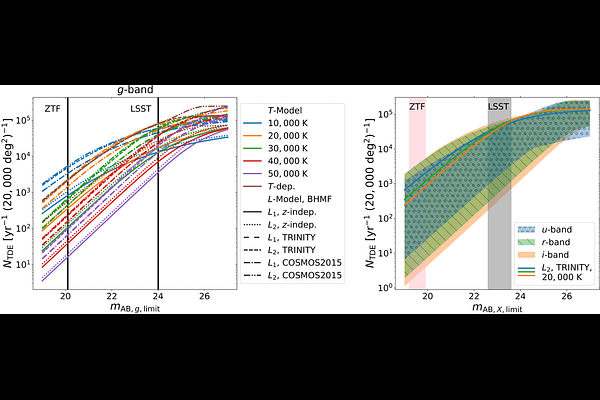Rates of Strongly Lensed Tidal Disruption Events

Rates of Strongly Lensed Tidal Disruption Events
E. Mamuzic, T. Ryu, S. H. Suyu, K. Szekerczes, S. Huber, L. Dai, M. Oguri
AbstractIn the coming years, surveys such as the Rubin Observatory's Legacy Survey of Space and Time (LSST) are expected to increase the number of observed Tidal Disruption Events (TDEs) substantially. We employ Monte Carlo integration to calculate the unlensed and lensed TDE rate as a function of limiting magnitude in $u$, $g$, $r$, and $i$-bands. We investigate the impact of multiple luminosity models, black hole mass functions (BHMFs), and flare temperatures on the TDE rate. Notably, this includes a semi-analytical model, which enables the determination of the TDE temperature in terms of black hole (BH) mass. We predict the highest unlensed TDE rate to be in $g$-band. It ranges from $16$ to $5,440\;\mathrm{yr}^{-1}\;(20,000\;\mathrm{deg}^2)^{-1}$ for the Zwicky Transient Facility, being more consistent with the observed rate at the low end. For LSST, we expect a rate in $g$-band between $3,580$ and $82,060\;\mathrm{yr}^{-1}\;(20,000\;\mathrm{deg}^2)^{-1}$. A higher theoretical prediction is understandable, as we do not consider observational effects such as completeness. The unlensed and lensed TDE rates are insensitive to the redshift evolution of the BHMF, even for LSST limiting magnitudes. The best band for detecting lensed TDEs is also $g$-band. Its predicted rates range from $0.43$ to $15\;\mathrm{yr}^{-1}\;(20,000\;\mathrm{deg}^2)^{-1}$ for LSST. The scatter of predicted rates reduces when we consider the fraction of lensed TDEs; that is, a few in ten thousand TDEs will be lensed. Despite the large scatter in the rates of lensed TDEs, our comprehensive considerations of multiple models suggest that lensed TDEs will occur in the $10$-year LSST lifetime, providing an exciting prospect for detecting such events. We expect the median redshift of a lensed TDE to be between $1.5$ and $2$. In this paper, we additionally report on lensed TDE properties, such as the BH mass and time delays.